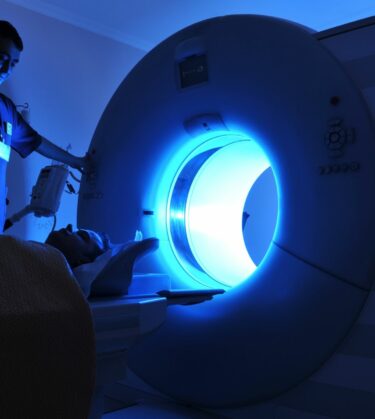
Prostate screening
Checking prostate health can be an invasive, uncertain and lengthy process, but at Prime Health we’re committe...

Prostate cancer is one of the most common cancer in men and, in the UK, and there are more than 50,000 cases diagnosed each year. As with all cancers, early detection matters a great deal when it comes to successful treatment. An MRI scan of the prostate is at the forefront of this diagnostic process and has helped many people recover and lead a normal healthy life.
MRI stands for magnetic resonance imaging and allows medical staff to get detailed images of any area of the body, including the prostate. It uses a mix of strong magnetic fields and radio waves and is a less invasive process than taking a tissue biopsy.
During an MRI scan, you lie on a bed that moves into the circular scanner. The computerised system is operated by a qualified and experienced radiographer. The MRI machine distinguishes between different types of tissue and organs within the body and creates a series of high quality images.
The key to an MRI scan is not just in the technology itself but in how the results are interpreted. An experienced radiologist can identify potentially cancerous cells in an area like the prostate and see whether it is confined to just one area or if it has spread to other surrounding tissues.
The MRI scan is not the end of the diagnostic process. If cancer is suspected then a prostate biopsy may also be required – that means taking a small amount of tissue for examination under laboratory conditions. This can help identify the type of cancer cells and dictate how the disease should be treated.
Here we look at the role of an MRI scan in prostate cancer diagnosis and explore why it’s an important tool in early detection and treatment in combination with other diagnostic approaches.
The prostate gland is a small gland that is about the size of a table tennis ball and it is primarily involved in reproduction by delivering seminal fluid for the transportation of sperm. It is found in the groin area, between the penis and the rectum and is controlled by the release of various androgens or sex hormones that begin to appear during puberty.
Any cancer starts when normal cells start to grow abnormally and their development cannot be stopped by common healthy cell safeguards. Prostate cancer is often slow in developing and does not tend to spread outside of the gland prior to diagnosis.
The symptoms of prostate cancer include:
If you are over 50, you may be familiar with the traditional prostate gland examination. This is where your doctor inserts a finger to manually check the prostate. Here they are assessing whether the prostate gland is enlarged, something which is concerning and may require further investigation.
Another more recent tool is the PSA (prostate-specific antigen) blood test. This is less invasive and involves taking a blood sample and checking your PSA level. Higher levels of this antigen are seen due to a variety of prostate conditions but may indicate that there could potentially be prostate cancer.
While simple to administer, neither of these two tests is definitive which is why the next step of the diagnostic process may be an MRI scan and/or a prostate biopsy.
It’s important to note that just because you have an enlarged prostate gland and have symptoms such as difficulty urinating, it doesn’t necessarily mean you have prostate cancer. There is a common condition called benign prostate enlargement that is non-cancerous and affects men as they get older.

According to Cancer Research UK:
The good news is that, because of effective screening and testing tools such as MRI scans, the survival rates for prostate cancer are relatively high in modern society. More than 77% of men diagnosed with the disease survive more than ten years and, when the diagnosis is made in the early stages, there is nearly a 100% survival rate.
It’s generally understood that, with any cancer, the earlier you can get a diagnosis the better the prognosis. While some prostate cancer develops slowly, it’s important that your consultant understands whether cancer has spread into the surrounding area and what type of cancer it is.
It’s important that if you notice symptoms such as a persistent difficulty urinating you go for a check-up with your doctor. While uncomfortable, having a digital rectal exam (DRE) every year can help spot potential issues early, even if you are not exhibiting symptoms, when you are over a certain age or if you have a family history of prostate cancer.

While the PSA blood test and a DRE can indicate a problem, we really need to see what is happening in your prostate. MRI scans provide a relatively easy way to produce quality images of practically any organ in the body and identify potential cancer cells.
Multi-parametric MRI scanners are often used because they can produce more detailed images of areas like the prostate gland. The options open to hospitals are to do the prostate biopsy first and test in the lab for cancer and then run an MRI scan or the other way around.
The benefit of undertaking the MRI scan first is that it can identify what area of the prostate to take the biopsy sample from, thereby reducing the need to take samples from all over the prostate. An MRI scan has little to no side effects or risks associated with it.
Results can be analysed quickly by experienced radiologists that specialise in prostate cancer.
MRI scanners are not a new technology, the first MRI device for medical use was developed in the 1980s, but there have been significant advances over the decades. Today, many hospitals have magnetic resonance imaging scanners that can produce high quality images, making them one of the most important diagnostic tools in the fight against cancer.
MRI images are produced using a mix of powerful magnets and radio waves. To put it simply, our bodies contain protons found in water molecules and these each act as tiny magnets in their own right. When the MRI scanner is switched on, it aligns these protons in the same direction.
Radio waves are then added to the mix and directed at specific areas of the body, in this case, the prostate gland. This knocks the protons out of alignment. When the radio waves stop, the magnetic effect again realigns everything. This process, using sophisticated software, allows us to create a detailed picture of the area being investigated.
When you provide high-quality images of any part of the body, the key is in how what is shown is interpreted. An important part of prostate imaging is the input of an experienced radiographer and MRI specialist who looks at the images and interprets the results.
MRI scans are generally seen as very safe. Extensive research has been undertaken on any biological effects it might cause and it has been determined that it is an extremely safe and non-invasive examination and for most people, there are no adverse side effects.
Lying in a scanner can be a daunting experience. Not only are you worried about whether you have cancer or not but you are in an environment that is alien to you. The scanner itself can be very noisy and you have to keep still for as long as the scan takes, which is usually about half an hour.
The process can involve administering a contrast material called gadolinium. This is an injection of a dye that helps create a greater contrast in the scan images. If you need a contrast medium, you may also need to have a blood test before your scan as a precaution and to check your kidney function. Your radiologist will monitor you and explain any risks, but an allergic reaction to gadolinium is rare and usually very mild.
It is not recommended for those who have a device fitted such as a pacemaker, metal implants such as an artificial joint or pieces of metal inside your body. In these cases, you are more likely to be recommended for a prostate biopsy and other diagnostic tools such as ultrasound which can be useful as alternatives.
In general, you can’t just book an MRI scan. You are required to have a referral from a medical professional. Your doctor needs a good reason to book you in for a scan and why, for a prostate, it’s only recommended after the initial PSA test and DRE are carried out either following a routine checkup or after you have disclosed that you may have symptoms of an enlarged prostate.
An MRI scan can be used to produce almost immediate images of the prostate gland and any suspicious areas which can then be examined by a qualified specialist radiographer to give you more insight into what is going on.
There is some variation between hospitals as to whether an MRI scan is carried out first or a biopsy. In some places, a prostate MRI scan is carried out first because it gives an idea of where there may be cancerous cells and this can dictate which part of the prostate the biopsy is taken from.
The MRI scan can also help your doctor decide whether you need a biopsy at all, which is invasive and can be an uncomfortable process.

An MRI scan for prostate cancer involves very little effort on your part except following the instructions of the radiography team. You will usually wear a hospital gown and be asked to lie on a table. In some cases, a contrast material called gadolinium is injected to produce higher quality images through an MRI machine.
When lying on the table you will be surrounded by a tube or doughnut-shaped structure which is the MRI scanner. It does not touch you but may be noisy when in operation and you might feel a little warmth in the area being examined. Apart from this, there should be no side effects.
The whole process of prostate imaging can take about 30 to 40 minutes and the appointment should last around an hour. The biggest challenge you may have is staying still and comfortable during that time, but the radiographers will do all they can to help.
There will be a protected area, or side room near the scanner, where the radiographer collects the images of your prostate using specialist high-tech software.
If you are going through the NHS, you can usually expect to wait between one and two weeks for your results after they have been examined by a specialist. If you are going through a private clinic, you can normally expect those results within 24 to 48 hours.
A qualified radiographer and a medically qualified MRI specialist (radiologist) are able spot potentially cancerous cells in the images that the scanner provides. They will be able to visually identify cancerous cells and see whether the cancer is located in one area, what size it is or if it has spread or metastasised outside of the prostate.
When identifying areas of concern, the radiologist needs to decide how clinically significant they are. To do this they use a tool called the Prostate Imaging Reporting and Data System or PI-RADS. This allows them to score the abnormality on a scale of 1 to 5 as follows:
In short, different types of soft tissue emit different intensities depending on what they are. Radiologists are trained to identify those cells that appear to be cancerous in the images that they see.
If you have a digital rectal exam (DRE), a doctor may be able to feel whether cancer is likely to be present. In normal circumstances, the prostate gland feels smooth but with cancer, it can feel bumpy. With MRI, the bigger the tumour obviously the more it will show up on the scan and the easier it is to identify.
Any diagnosis of cancer is likely to be traumatic and life-changing but it’s important to note that with prostate cancer the prognosis is generally good and treatments today are highly effective.
A prostate biopsy will help identify the type of cancer cells, and the extent of the disease. This, in turn, will dictate the treatment that is going to be offered. What the approach is will depend on a wide range of factors.
If the tumour is small and developing slowly, you may not need any treatment at all. The tumour is contained and is unlikely to be life threatening and doctors will monitor the condition at regular intervals.
Like other diseases, prostate cancer is assessed over different stages. For advanced stages, where cancer has spread to other organs, the appropriate treatment may be palliative rather than curative.
There are several potential treatment options for prostate cancer. These include but aren’t limited to surgery, radiotherapy, chemotherapy, hormone therapy and high-intensity focused ultrasound. Or combinations of all of these. Your consultant urologist or oncologist will provide you with advice, but you may wish to do your own research and/or seek a second opinion.

An MRI scan is an important part of the diagnostic process and can be used to identify prostate cancer.
At Prime Health, we provide state-of-the-art MRI imaging and access to highly qualified and experienced radiographers and fast diagnostic results.
At Prime Health, we use a 3T Siemen’s Scanner that has been carefully optimised to produce fast and accurate results for prostate scans. In addition, the use of diffusion-weighted and contrast-enhanced imaging means that we can produce pin-point clear images with this type of MRI.
The high degree of optimisation built into the system is critical for not only identifying potential tumours but also helps us to stage prostate cancer to give a more accurate diagnosis to our patients.
Even with the best equipment in the world, it would be difficult to offer an accurate diagnosis for prostate cancer without fully qualified staff operating the MRI machine and interpreting the results. We work with some of the UK’s most experienced consultant radiologists in the UK, people who are specialists in prostate cancer and its diagnosis.
These individuals have been at the cutting edge of prostate MRI diagnosis and research for more than a decade and regularly audit each other’s work to ensure quality control, accurate results and then correlate these with future prostate biopsies.
At Prime Health we work with these individuals on a daily basis to produce accurate and fast diagnostic services that make a real difference to people’s lives.
Key to using a clinic like Prime Health is speed and peace of mind. Once your doctor contacts us to refer you as a patient, you can expect a fast response, early appointment and a report that is full and comprehensive.
While the challenge of being diagnosed with a cancer can be highly traumatic, so can the wait for results. Whether it’s an all clear with nothing to worry about or something more serious, it means you have the right information at hand much sooner.
Once you have had your MRI scan, a qualified and highly experienced radiologist will look at the images and then complete a report that is sent to your doctor. Rather than the standard text report that you normally see, Prime Health has worked with an expert team of urologists to produce a report that gives a full and comprehensive outline of the scan results and what they do and do not mean.
What this usually covers includes:
The aim of our process is to make referral and scanning as fast, efficient and seamless as possible. This means you get your appointment quickly and the results soon after.
While prostate cancers are often seen as slow-developing tumours, speed is still important when it comes to diagnosis. At Prime Health, 90% of our scan results and reports are sent out to the doctor within 48 hours and many can be completed in just over 1 day. This compares to around 1 to 2 weeks or sometimes longer with the NHS.
When you combine this with our state of the art multiparametric MRI and its ability to produce exceptionally high resolution images, choosing a clinic like Prime Health can make a huge difference to your future wellbeing.
You can book an MRI scan directly with Prime Health through our MRI Prostate Health Check service. Available across all our centres in Surrey, London, Manchester and Brighton, our new service enables you to self-refer for an MRI with a PSA result.
Prime Health offers a wide range of health care services ranging from general GP care to orthopaedics and urological services. We have several key diagnostic tools on site across our centres including MRI scanners, X-ray, ultrasound and CT scan.
Our multi parametric prostate scans have been developed over the last ten years in cooperation with some of the leading medical experts in the world. A multi parametric approach greatly increases the accuracy of a scan which is highly important when using it to test for cancer cells in the prostate.
One of the key advantages of coming to Prime Health for your MRI scan is that we have access to a wide range of expert radiologists who work with us constantly to help improve our service. With multi-disciplinary teams at the forefront of health and care excellence, patients can be sure that they are getting fast and accurate diagnoses at all times.
Of course, being tested to see if you have cancer is highly traumatic and that’s why you can be sure of a friendly welcome, professionalism and our full attention at all times.
Prostate cancer is one of the leading cancers in men over 50 and more than 52,000 each year are diagnosed with it. Early detection is key when it comes to any form of cancer and one of the key tools in this battle for quick diagnosis is the use of technology such as the MRI scan.
There’s no doubt that MRI scans have transformed the effectiveness of cancer care over the last 40 years by facilitating early detection. Today’s magnetic resonance machines use state-of-the-art technology and software to make it easier to detect tumours in many parts of the body.
At Prime Health, we’ve made it our mission to provide patients with diagnostic tools that help transform their lives and lead to a full recovery in many cases.
Want to find out more? Ask your doctor for a referral to Prime Health and book an appointment for our multiparametric 3T MRI scan today.
You may be interested in reading more on:
How to prepare for an MRI of the prostate
Men’s full health check | Which screening tests do I need?
An overview of prostate cancer; the symptoms, diagnostic tests and treatment
To book your prostate MRI scan today with Prime Health – Click here
We’ve developed a streamlined, fast-track pathway which utilises our years of experience and expertise in accurately and effectively assessing prostate symptoms.
Don’t wait for a prostate assessment. Wait less, worry less.
